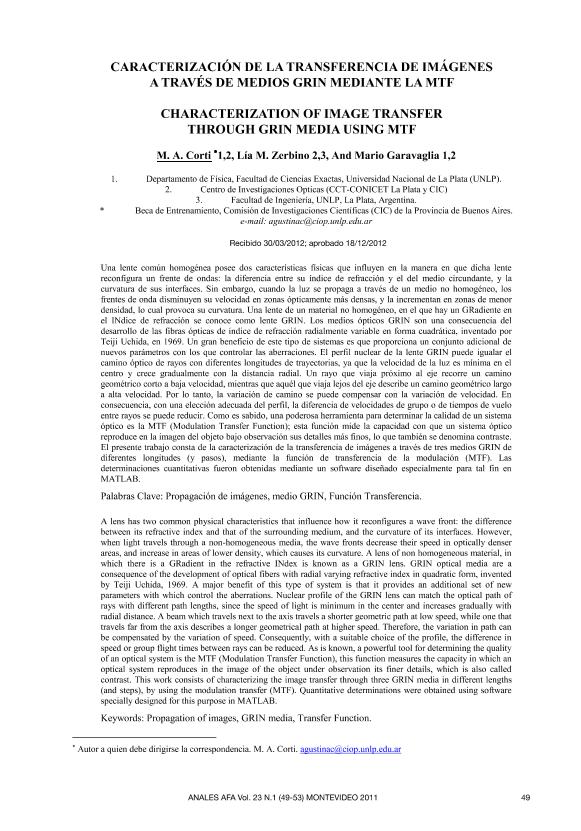Mostrar el registro sencillo del ítem
dc.contributor.author
Corti, Maria Agustina

dc.contributor.author
Zerbino, Lia Maria

dc.contributor.author
Garavaglia, Mario Jose

dc.date.available
2016-09-05T18:05:59Z
dc.date.issued
2013-01
dc.identifier.citation
Corti, Maria Agustina; Zerbino, Lia Maria; Garavaglia, Mario Jose; Caracterizacion de la transferencia de imagenes a traves de medios grin mediante la mtf; Asociación Física Argentina; Anales AFA; 23; 1; 1-2013; 49-53
dc.identifier.issn
0327-358X
dc.identifier.uri
http://hdl.handle.net/11336/7429
dc.description.abstract
Una lente común homogénea posee dos características físicas que influyen en la manera en que dicha lente reconfigura un frente de ondas: la diferencia entre su índice de refracción y el del medio circundante, y la curvatura de sus interfaces. Sin embargo, cuando la luz se propaga a través de un medio no homogéneo, los frentes de onda disminuyen su velocidad en zonas ópticamente más densas, y la incrementan en zonas de menor densidad, lo cual provoca su curvatura. Una lente de un material no homogéneo, en el que hay un GRadiente en el INdice de refracción se conoce como lente GRIN. Los medios ópticos GRIN son una consecuencia del desarrollo de las fibras ópticas de índice de refracción radialmente variable en forma cuadrática, inventado por Teiji Uchida, en 1969. Un gran beneficio de este tipo de sistemas es que proporciona un conjunto adicional de nuevos parámetros con los que controlar las aberraciones. El perfil nuclear de la lente GRIN puede igualar el camino óptico de rayos con diferentes longitudes de trayectorias, ya que la velocidad de la luz es mínima en el centro y crece gradualmente con la distancia radial. Un rayo que viaja próximo al eje recorre un camino geométrico corto a baja velocidad, mientras que aquél que viaja lejos del eje describe un camino geométrico largo a alta velocidad. Por lo tanto, la variación de camino se puede compensar con la variación de velocidad. En consecuencia, con una elección adecuada del perfil, la diferencia de velocidades de grupo o de tiempos de vuelo entre rayos se puede reducir. Como es sabido, una poderosa herramienta para determinar la calidad de un sistema óptico es la MTF (Modulation Transfer Function); esta función mide la capacidad con que un sistema óptico reproduce en la imagen del objeto bajo observación sus detalles más finos, lo que también se denomina contraste. El presente trabajo consta de la caracterización de la transferencia de imágenes a través de tres medios GRIN de diferentes longitudes (y pasos), mediante la función de transferencia de la modulación (MTF). Las determinaciones cuantitativas fueron obtenidas mediante un software diseñado especialmente para tal fin en MATLAB.
dc.description.abstract
A lens has two common physical characteristics that influence how it reconfigures a wave front: the difference between its refractive index and that of the surrounding medium, and the curvature of its interfaces. However, when light travels through a non-homogeneous media, the wave fronts decrease their speed in optically denser areas, and increase in areas of lower density, which causes its curvature. A lens of non homogeneous material, in which there is a GRadient in the refractive INdex is known as a GRIN lens. GRIN optical media are a consequence of the development of optical fibers with radial varying refractive index in quadratic form, invented by Teiji Uchida, 1969. A major benefit of this type of system is that it provides an additional set of new parameters with which control the aberrations. Nuclear profile of the GRIN lens can match the optical path of rays with different path lengths, since the speed of light is minimum in the center and increases gradually with radial distance. A beam which travels next to the axis travels a shorter geometric path at low speed, while one that travels far from the axis describes a longer geometrical path at higher speed. Therefore, the variation in path can be compensated by the variation of speed. Consequently, with a suitable choice of the profile, the difference in speed or group flight times between rays can be reduced. As is known, a powerful tool for determining the quality of an optical system is the MTF (Modulation Transfer Function), this function measures the capacity in which an optical system reproduces in the image of the object under observation its finer details, which is also called contrast. This work consists of characterizing the image transfer through three GRIN media in different lengths (and steps), by using the modulation transfer (MTF). Quantitative determinations were obtained using software specially designed for this purpose in MATLAB.
dc.format
application/pdf
dc.language.iso
spa
dc.publisher
Asociación Física Argentina

dc.rights
info:eu-repo/semantics/openAccess
dc.rights.uri
https://creativecommons.org/licenses/by-nc-sa/2.5/ar/
dc.subject
Propagacion de Imagenes
dc.subject
Medio Grin
dc.subject
Funcion Transferencia.
dc.subject.classification
Óptica

dc.subject.classification
Ciencias Físicas

dc.subject.classification
CIENCIAS NATURALES Y EXACTAS

dc.title
Caracterizacion de la transferencia de imagenes a traves de medios grin mediante la mtf
dc.title
Characterization of image transfer through grin media using mtf
dc.type
info:eu-repo/semantics/article
dc.type
info:ar-repo/semantics/artículo
dc.type
info:eu-repo/semantics/publishedVersion
dc.date.updated
2015-11-05T16:53:57Z
dc.journal.volume
23
dc.journal.number
1
dc.journal.pagination
49-53
dc.journal.pais
Argentina

dc.journal.ciudad
Tandil
dc.description.fil
Fil: Corti, Maria Agustina. Consejo Nacional de Investigaciones Científicas y Técnicas. Centro Científico Tecnológico la Plata. Centro de Investigaciones Opticas (i); Argentina. Universidad Nacional de La Plata. Facultad de Ciencias Exactas; Argentina
dc.description.fil
Fil: Zerbino, Lia Maria. Consejo Nacional de Investigaciones Científicas y Técnicas. Centro Científico Tecnológico La Plata. Centro de Investigaciones Opticas (i); Argentina. Universidad Nacional de La Plata. Facultad de Ingenieria; Argentina
dc.description.fil
Fil: Garavaglia, Mario Jose. Universidad Nacional de La Plata. Facultad de Ciencias Exactas; Argentina. Consejo Nacional de Investigaciones Científicas y Técnicas. Centro Científico Tecnológico La Plata. Centro de Investigaciones Opticas (i); Argentina
dc.journal.title
Anales AFA

dc.relation.alternativeid
info:eu-repo/semantics/altIdentifier/url/http://anales.fisica.org.ar/journal/index.php/analesafa/article/view/964
Archivos asociados
